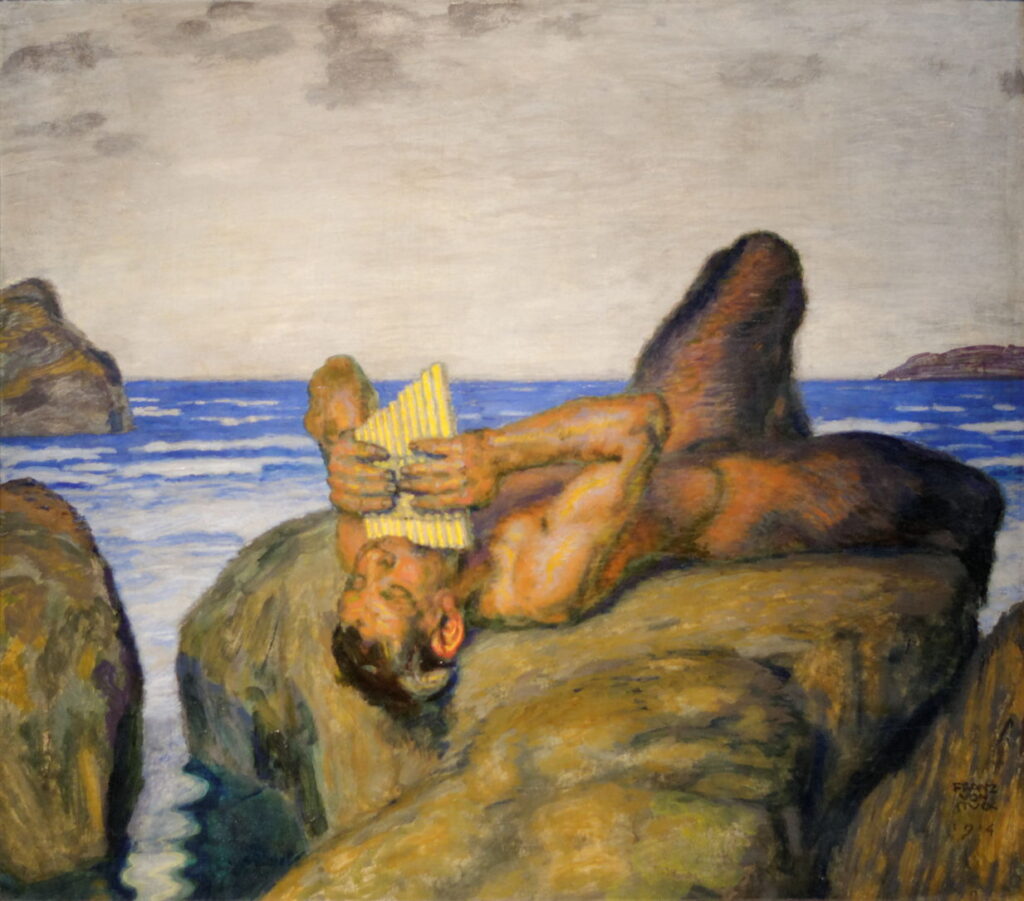Reading visual art: 131 Reed pipes

As well as the lyre, wind instruments have been popular in paintings. These are normally a single or double pipe, known in Ancient Greek as the aulos (αὐλός), a reed instrument related to the modern oboe or bagpipes, or multiple pipes made from reeds, known as the syrinx, the modern Pan pipes often encountered in South American folk music, where they’re known as the siku. Some artists have used them interchangeably, which can become confusing, but this selection of paintings includes only the latter.
Their aetiological myth is told as a story within a story in Ovid’s Metamorphoses, introduced when Mercury tries to lull Argus to sleep by playing his reed pipes. When that fails, the god resorts to telling the story of Pan’s lusting and attempted rape of the beautiful Naiad Syrinx.
Just as Pan is about to catch Syrinx up, she implores her sisters to transform her and is turned into reeds, leaving Pan clutching at them. When Pan sighs, those reeds are blown by the wind and emit their distinctive sound, so that her name is given to pipes made from her reeds.
François Boucher (1703–1770), Pan and Syrinx (1743), oil on canvas, 101 × 133 cm, Private collection. Wikimedia Commons.
François Boucher appears to have painted this story many times, and his Pan and Syrinx from 1743 is probably his finest version, even though it only alludes to her transformation rather than showing it.
Mikhail Vrubel (1856–1910), Pan (1899), oil on canvas, 124 x 106 cm, Tretyakov Gallery Государственная Третьяковская галерея, Moscow, Russia. Wikimedia Commons.
Mikhail Vrubel’s Pan from 1899 clutches his pipes, and is partly dressed in animal skins, with a brilliantly aged left hand. A waning crescent moon hangs just above the horizon.
Nicolas Poussin (1594–1665), The Triumph of Pan (1636), oil on canvas, 135.9 x 146 cm, The National Gallery, London. Wikimedia Commons.
Nicolas Poussin’s The Triumph of Pan from 1636 surprises by its unbridled Bacchic revelry. The red-faced term at the back, who is perhaps Pan, is apparently being brought to life by the caress of the central Maenad in blue. None of these figures is part-goat, although another Maenad wearing blue is riding one, but Pan’s pipes are resting on the ground in the left foreground, next to a thyrsus.
Pan also appears in several mythical narratives, of which the best-known must be the story of King Midas, also retold in Ovid’s Metamorphoses. It starts when King Midas had developed a real loathing for riches as everything that he touched turned to gold. He then led an outdoor life in Pan’s company, but unfortunately continued to do stupid things. Pan sang and played his pipes, making music he claimed was even better than that of the god Apollo, a boast that resulted in a contest between them, with Tmolus as the judge.
Pan played first, then Apollo, and Tmolus gave his verdict in favour of Apollo’s lyre, to everyone’s pleasure, apart from Midas who considered that unjust. In return, Apollo transformed the ears of Midas into those of an ass.
Domenichino (1581–1641) and workshop, The Judgement of Midas (Villa Aldobrandini Frescoes) (1616-18), fresco transferred to canvas and mounted on board, 267 x 224 cm, The National Gallery (Bought, 1958), London. Courtesy of and © The National Gallery, London.
Domenichino included The Judgement of Midas as part of the superb frescoes he and his workshop painted in the Villa Aldobrandini in 1616-18. Midas stands proud in his folly, his ass’s ears plain to see, with Apollo and Pan on each side.
Hendrick de Clerck (1560/1570–1630), The Contest Between Apollo and Pan (c 1620), oil on copper, 43 x 62 cm, Rijksmuseum Amsterdam, Amsterdam, The Netherlands. Wikimedia Commons.
This jewel of a painting by Hendrick de Clerck, showing The Contest Between Apollo and Pan and painted in about 1620, just after Domenichino’s frescoes, is truly beautiful. Pan holds his pipes and dances at the right, and Apollo is seen bowing an early form of violin just to the left of centre. Between them are Tmolus, the judge next to Apollo, and Midas, with his ass’s ears. Seven Graces are also present, and Minerva is talking to Apollo.
Émile Lévy (1826–1890), The Judgement of Midas (1870), oil on canvas, 182 x 115 cm, Musée Fabre, Montpellier, France. Wikimedia Commons.
Émile Lévy’s painting of The Judgement of Midas was completed in 1870, and is clean and uncluttered. Apollo stands in disdain, in a position which would appear seriously homoerotic. Seated, with his ass’s ears and a facile smile all over his face is King Midas, who is passing a gold laurel crown, a reference to his earlier golden touch, to Pan, who holds his pipes aloft in victory.
Cornelis van Haarlem (1562–1638), The Wedding of Peleus and Thetis (1593), oil on canvas, 246 x 419 cm, Frans Hals Museum, Haarlem, The Netherlands. Wikimedia Commons.
Reed pipes are often a good indication that Pan isn’t far away. In Cornelis van Haarlem’s The Wedding of Peleus and Thetis from 1593, he’s near his pipes, at the left, and clearly having a good time.
The pipes are also more generally associated with fauns.
John William Waterhouse (1849–1917), Hamadryad (1893-95), oil on canvas, 158 × 59.5 cm, Plymouth City Museum and Art Gallery, Plymouth, England. Wikimedia Commons.
John William Waterhouse’s Hamadryad from 1893-95 is watching a young faun playing the reed pipes. At his feet is a thyrsus, tipped with a pine cone, referring to Maenads or Bacchantes.
Franz von Stuck (1863–1928), Dissonance (1910), media and dimensions not known, Museum Villa Stuck, Munich, Germany. Wikimedia Commons.
Fauns, some of Franz von Stuck’s earliest and favourite mythical creatures, turn up in some brilliantly humorous paintings. In Dissonance (1910), a young faun is struggling to make musical sounds from the reed pipes he holds so intently. The resulting noise is making the older faun next to him suffer badly.
Franz von Stuck (1863–1928), The Old Faun (c 1910-13), media and dimensions not known, Museum Villa Stuck, Munich, Germany. Image by Yelkrokoyade, via Wikimedia Commons.
The Old Faun (c 1910-13) reverses the roles: here a much older faun is playing his reed pipes, eliciting admiration from two younger fauns who stand in their amazement at his musical skill.
Franz von Stuck (1863–1928), A Faun Blowing Reed-Pipes (1914), media and dimensions not known, Museum Villa Stuck, Munich, Germany. Image by Yelkrokoyade, via Wikimedia Commons.
Von Stuck continued to delight in exploring the mythical life of fauns, and in particular their playing reed pipes, in A Faun Blowing Reed-Pipes (1914).
From these, shepherds are sometimes depicted with a set of reed pipes, in this case a bucolic episode from Torquato Tasso’s epic Jerusalem Delivered.
Domenichino (1581–1641), Erminia and the Shepherds (1622-25), oil on canvas, 124 x 181 cm, Musée du Louvre, Paris. Image by Mbzt, via Wikimedia Commons.
Domenichino appears to have been one of the earliest major painters to capture Erminia and the Shepherds, painted between 1622-25. He recasts Tasso’s story in classical times, with Erminia appearing more Roman than Syrian, and the shepherds are straight out of an Ovidian myth. This is all set in a wonderfully imaginative riparian landscape, as shown in the detail below.
Domenichino (1581–1641), Erminia and the Shepherds (detail) (1622-25), oil on canvas, 124 x 181 cm, Musée du Louvre, Paris. Image by Mbzt, via Wikimedia Commons.
Although classical accounts of the ill-fated musical contest between Marsyas and Apollo make it clear that the satyr competed on the aulos rather than reed pipes, there’s one prominent painting in which Marsyas is given pipes.
Titian (Tiziano Vecelli) (1490–1576), The Flaying of Marsyas (c 1570-1576), oil on canvas, 212 × 207 cm, Arcidiecézní muzeum Kroměříž, Olomouc Museum of Art, Kroměříž, The Czech Republic. Wikimedia Commons.
This most famous painting of The Flaying of Marsyas was one of Titian’s last works, and painted between 1570 and his death in 1576. The satyr has been strung up by his legs from a tree, his arms also bound, and is now having his skin and hide cut off, Apollo kneeling at the left with his blade at Marsyas’ chest. Standing above the god is one of the Muses, playing her string instrument and gazing upwards. Near her left hand are Pan pipes, rather than an aulos, strung from the tree next to the body of the satyr.




